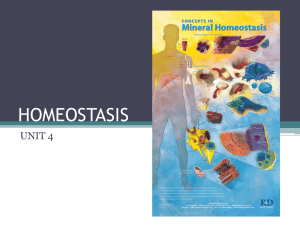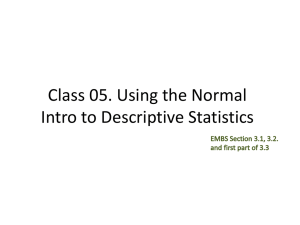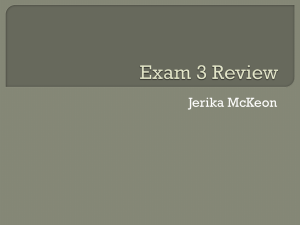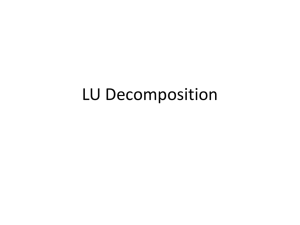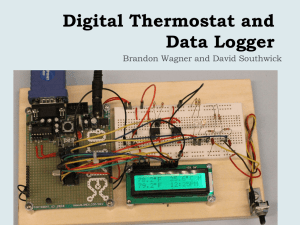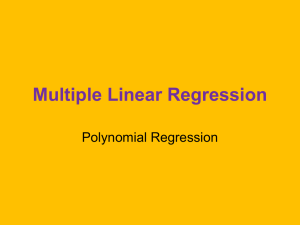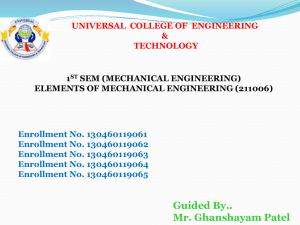STATISTICAL LABORATORY WORKSHOP
advertisement
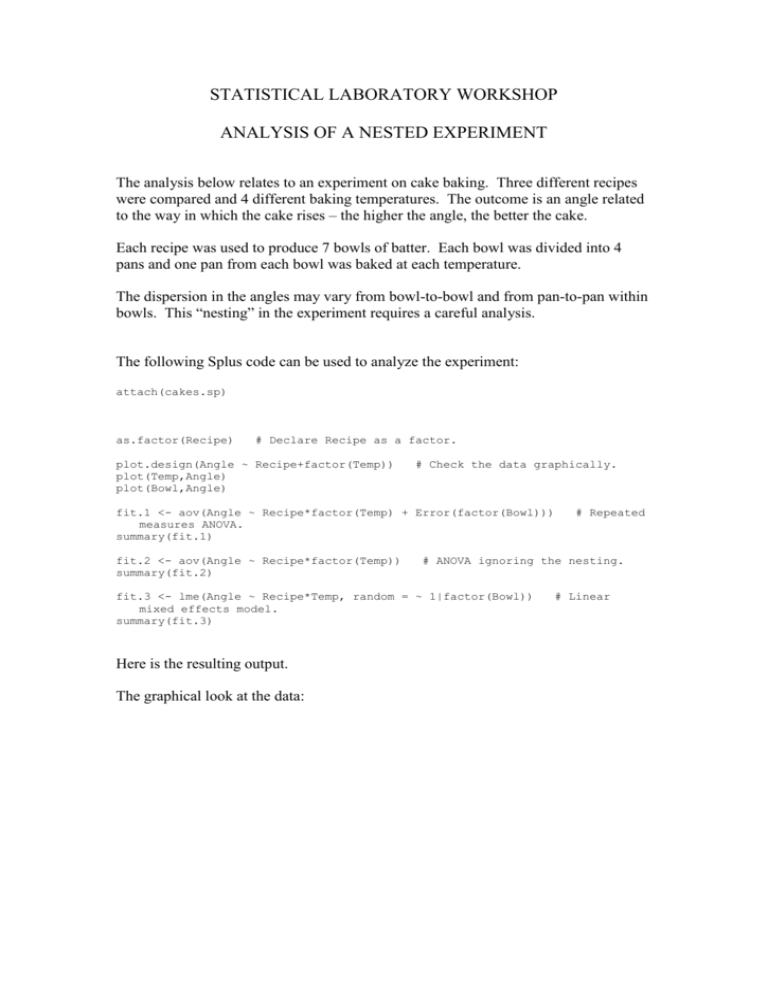
STATISTICAL LABORATORY WORKSHOP ANALYSIS OF A NESTED EXPERIMENT The analysis below relates to an experiment on cake baking. Three different recipes were compared and 4 different baking temperatures. The outcome is an angle related to the way in which the cake rises – the higher the angle, the better the cake. Each recipe was used to produce 7 bowls of batter. Each bowl was divided into 4 pans and one pan from each bowl was baked at each temperature. The dispersion in the angles may vary from bowl-to-bowl and from pan-to-pan within bowls. This “nesting” in the experiment requires a careful analysis. The following Splus code can be used to analyze the experiment: attach(cakes.sp) as.factor(Recipe) # Declare Recipe as a factor. plot.design(Angle ~ Recipe+factor(Temp)) plot(Temp,Angle) plot(Bowl,Angle) # Check the data graphically. fit.1 <- aov(Angle ~ Recipe*factor(Temp) + Error(factor(Bowl))) measures ANOVA. summary(fit.1) fit.2 <- aov(Angle ~ Recipe*factor(Temp)) summary(fit.2) # ANOVA ignoring the nesting. fit.3 <- lme(Angle ~ Recipe*Temp, random = ~ 1|factor(Bowl)) mixed effects model. summary(fit.3) Here is the resulting output. The graphical look at the data: # Repeated # Linear 36 205 35 195 34 2 33 mean of Angle 3 1 32 185 175 Recipe1 factor(Temp) 35 20 25 30 Angle 40 45 50 Factors 175 180 185 190 195 200 205 35 30 25 20 Angle 40 45 50 Temp 5 10 15 Bowl 20 The repeated measures ANOVA: summary(fit.1) Error: factor(Bowl) Df Sum of Sq Mean Sq F Value Pr(F) Recipe1 2 40.500 20.2500 0.08657663 0.9174448 Residuals 18 4210.143 233.8968 Error: Within Df Sum of Sq Mean Sq F Value Pr(F) factor(Temp) 3 306.952 102.3175 4.594986 0.0061659 Recipe1:factor(Temp) 6 77.119 12.8532 0.577225 0.7467591 Residuals 54 1202.429 22.2672 ANOVA ignoring the nesting: > fit.2 <- aov(Angle ~ Recipe1 * factor(Temp)) > # ANOVA ignoring the nesting. summary(fit.2) Df Sum of Sq Mean Sq F Value Pr(F) Recipe1 2 40.500 20.2500 0.269373 0.7646248 factor(Temp) 3 306.952 102.3175 1.361064 0.2615823 Recipe1:factor(Temp) 6 77.119 12.8532 0.170978 0.9837826 Residuals 72 5412.571 75.1746 Note that the residual sum of squares combines the separate residual sums of squares in the original analysis. The large bowl-to-bowl variation gives a much higher residual mean square for the temperature effect, which now fails to reach statistical significance. The linear mixed effects model, which includes a random effect for bowls, but uses a linear regression model for the temperature effect rather than an ANOVA model. > fit.3 <- lme(Angle ~ Recipe1 * Temp, random = > # Linear mixed effects model. summary(fit.3) Linear mixed-effects model fit by REML Data: NULL AIC BIC logLik 560.55 579.4037 -272.275 ~ 1 | factor(Bowl)) Random effects: Formula: ~ 1 | factor(Bowl) (Intercept) Residual StdDev: 7.291322 4.609049 Fixed effects: Angle ~ Recipe1 * Value Std.Error (Intercept) 2.59048 8.70753 Recipe11 -11.02857 10.66450 Recipe12 2.85476 6.15715 Temp 0.16381 0.04498 Recipe11Temp 0.06143 0.05509 Recipe12Temp -0.01333 0.03181 Temp DF t-value p-value 60 0.297498 0.7671 18 -1.034138 0.3148 18 0.463650 0.6485 60 3.641853 0.0006 60 1.115085 0.2693 60 -0.419215 0.6766 Standardized Within-Group Residuals: Min Q1 Med Q3 Max -2.019586 -0.6278114 -0.04249586 0.5601622 2.36891 Number of Observations: 84 Number of Groups: 21 Below are code and output from an analysis in SPSS. The default analysis in SPSS breaks down the sum of squares due to the “within bowls” factor using a set of orthogonal contrasts. I chose to use polynomial contrasts (the default), so that the temperature effect is decomposed into linear, quadratic and cubic components. To analyze these data in SPSS, each line in the file must give the data for 1 bowl and the 4 results for each bowl need to be entered as distinct variables. These variables are called Angle1, …, Angle4 in my data file. The command WSFACTOR declares that these four outcomes differ because of “temp”. Here is the code: GLM Angle1 Angle2 Angle3 Angle4 BY Recipe /WSFACTOR = temp 4 Polynomial /METHOD = SSTYPE(3) /CRITERIA = ALPHA(.05) /WSDESIGN = temp /DESIGN = Recipe . Here is some of the output: Te sts of W ithi n-Subje cts Effects Measure: MEA SURE_1 Source temp temp * Rec ipe Error(t emp) Sphericity Ass umed Greenhous e-Geiss er Huynh-Feldt Lower-bound Sphericity Ass umed Greenhous e-Geiss er Huynh-Feldt Lower-bound Sphericity Ass umed Greenhous e-Geiss er Huynh-Feldt Lower-bound Ty pe III Sum of Squares 306.952 306.952 306.952 306.952 77.119 77.119 77.119 77.119 1202.429 1202.429 1202.429 1202.429 df 3 2.252 2.876 1.000 6 4.503 5.751 2.000 54 40.530 51.760 18.000 Mean Square 102.317 136.323 106.746 306.952 12.853 17.125 13.410 38.560 22.267 29.668 23.231 66.802 F 4.595 4.595 4.595 4.595 .577 .577 .577 .577 Sig. .006 .013 .007 .046 .747 .700 .740 .572 Tests of Within-Subjects Contrasts Measure: MEASURE_1 Source temp temp * Recipe Error(temp) temp Linear Quadratic Cubic Linear Quadratic Cubic Linear Quadratic Cubic Type III Sum of Squares 281.752 .429 24.771 30.148 39.071 7.900 365.800 619.000 217.629 df 1 1 1 2 2 2 18 18 18 Mean Square 281.752 .429 24.771 15.074 19.536 3.950 20.322 34.389 12.090 F 13.864 .012 2.049 .742 .568 .327 Tests of Between-Subjects Effects Measure: MEASURE_1 Transformed Variable: Average Source Intercept Recipe Error Type III Sum of Squares 95478.857 40.500 4210.143 df 1 2 18 Mean Square 95478.857 20.250 233.897 F 408.209 .087 Sig. .000 .917 Sig. .002 .912 .169 .490 .576 .725
